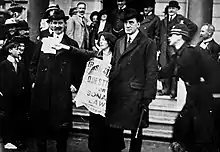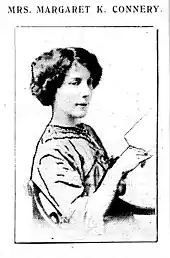Meg Connery
Meg Connery (1879–1956), was an Irish suffragist organiser and activist.
Margaret Connery | |
|---|---|
 Connery attempting to hand suffragist literature to Bonar Law (left) and Edward Carson (right) in 1912 | |
| Born | Margaret Knight 1879 Westport County Mayo |
| Died | 6 December 1958 Grangegorman |
| Nationality | Irish |
Life

Margaret Connery née Knight was born to parents John and Bridget Knight née Kelly in Westport, County Mayo. She was the third of nine children. One sister, Bridget was also involved in the suffragette movement in America. Her uncle, a Franciscan Friar encouraged her education. Her husband was John Patrick 'Con' Connery and they married while she was in her twenties. Little is known about her before her involvement with the Irish Women's Franchise League. 'Meg' Connery worked with Hanna Sheehy-Skeffington and was as becoming vice-chairwoman of the Irish Women's Franchise League. She was known for her activism, breaking windows and throwing rocks as well as demonstrating, working on the Irish Citizen and going to jail for the cause. She is particularly remembered for the photo taken of her distributing copies of the Irish Citizen to Bonar Law and Sir Edward Carson.[1][2][3][4]
Imprisonments and demonstrations
Connery had no illusions that women would vote in any way differently than men, or that they would use their vote more effectively. She was against the double standards that occurred between women and men. She wrote about it for The Irish Citizen more than once.[1][2][5][6][7][8][9][10]
In Ireland, as elsewhere, public morals must continue in an unhealthy state while we tolerate the shameful double moral standard
Despite her regular arrests for destruction of property Connery was entirely against the use of violence to gain the vote. She was jailed for a week in November 1911 after one demonstration and again in November 1912 when she was with the group who broke windows at the Custom House. In 1912 she heckled Winston Churchill. In 1914 Connery arranged for the first speeches on suffrage in Longford, Leitrim, and Roscommon. In January 1913 she again broke the windows of Dublin Castle and was arrested, this time getting one month's imprisonment. During this time, while in Tullamore, the women went on hunger strike as part of their demand to be treated as political prisoners. One of the other prisoners, Hoskins suffered heart failure and was released. The other women won their position.[1][2][5][6][7][8][9][10]
1914–1918
World War I saw the introduction of the contagious diseases act which Connery protested as she felt the purpose was to make sex safe for men, especially the soldiers and sailors. In 1915 the British government closed the North Sea for the number of days around the international women's peace conference in The Hague and Irish women were unable to attend. Connery chaired the Irish protest meeting about this in Dublin. Although the Representation of the People Act, 1918 gave a vote to women Connery was critical of the limited access given and continued to demand full equality.[1][11][8][8][9]
Other concerns
Connery was a member of the Irish Linen Worker's Union. She worked for improvements in working conditions. She also worked for the Irish White Cross and in 1922 she was part of a delegation to review the destruction in Tipperary and Cork by the wars in Ireland. Connery died of heart failure in December 1958.[1][12]
Further reading
- "Violence Ridicule and Silence". Google Cultural Institute. Retrieved 2018-12-06.
References and sources
- Cambridge University Press.
- Dublin City Council 1913.
- Moriarty 2013.
- History Ireland 2013.
- Ryan & Ward 2018, p. 29.
- Catalogue 1919.
- Ward 2017.
- Steele 2007, p. 179.
- Luddy 1995, p. 277.
- Reynolds 2007, p. 82.
- Mulhall 1915.
- Yeates 2012, p. 282.
- "Dictionary of Irish Biography". Cambridge University Press. Retrieved 2018-12-06.
- "SC034 Margaret Connery (1879-1956), Irish Citizen, 08 February 1913". Dublin City Council. 1913-02-08. Retrieved 2018-12-06.
- Mulhall, Ed (1915-05-11). "Pacificism or Physical Force? - Century Ireland". RTÉ Ireland's National Television and Radio Broadcaster. Retrieved 2018-12-06.CS1 maint: ref=harv (link)
- Ryan, L.; Ward, M. (2018). Irish Women and the Vote: Becoming Citizens, New Edition. Irish Academic Press. ISBN 978-1-78855-015-4. Retrieved 2018-12-06.CS1 maint: ref=harv (link)
- "Context: [Margaret Connery, Mabel Purser, Barbara Hoskins,..." Catalogue. 1919-07-10. Retrieved 2018-12-06.
- Yeates, P. (2012). A City in Turmoil – Dublin 1919–1921: The War of Independence. Dublin at War. Gill Books. ISBN 978-0-7171-5463-0. Retrieved 2018-12-06.CS1 maint: ref=harv (link)
- Ward, Margaret (2017-10-08). "When freedom was in the air, Irish suffragettes took steps to win equality". Independent.ie. Retrieved 2018-12-06.CS1 maint: ref=harv (link)
- Steele, K.M. (2007). Women, Press, and Politics During the Irish Revival. Irish studies. Syracuse University Press. ISBN 978-0-8156-3141-5. Retrieved 2018-12-06.CS1 maint: ref=harv (link)
- Luddy, M. (1995). Women in Ireland, 1800-1918: A Documentary History. Irish history. Cork University Press. ISBN 978-1-85918-038-9. Retrieved 2018-12-06.CS1 maint: ref=harv (link)
- Reynolds, P. (2007). Modernism, Drama, and the Audience for Irish Spectacle. Cambridge University Press. p. 82. ISBN 978-0-521-87299-7. Retrieved 2018-12-06.CS1 maint: ref=harv (link)
- Moriarty, Therese (2013-03-21). "Suffrage and socialism: links with Labour". The Irish Times. Retrieved 2018-12-06.CS1 maint: ref=harv (link)
- "Irish Women's Franchise League and Irish Women's Workers' Union". History Ireland. 2013-03-13. Retrieved 2018-12-06.
